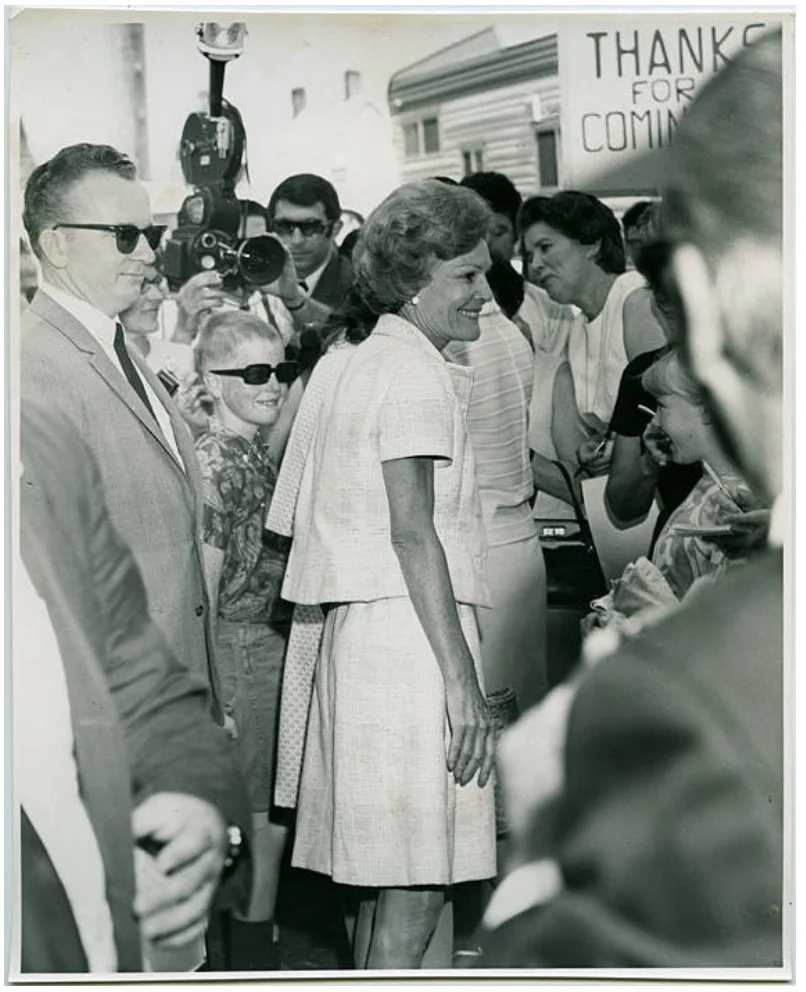Political Fashion: A Closer Look at How Women’s Fashion Shapes Politics
Fashion is a powerful tool in American politics, shaping perceptions and reflecting broader social climates. What the President, Vice President Kamala Harris, and the First Lady—or possibly the First Man in November—wear often carries political significance, subtly communicating messages to supporters and the global audience. Although the First Lady isn’t an elected official, her role puts her in the public eye, representing both the administration and the nation. As Valerie Steele, Director of the Museum at the Fashion Institute of Technology, told The Washington Post, "The first lady represents the administration…and more generally, the United States in the world."
Photo via New York Times
Fashion as a political tool is not a recent phenomenon. Since the founding of the United States, the style of women in politics has always been scrutinized and used to tell a story. Over the centuries, their fashion has evolved with changing times and trends, but their clothing often serves the same purposes: to communicate and reflect the era's spirit. Women in politics, through their influence, have also set fashion trends and become political celebrities, often swaying public opinion as much as their husbands, if not more. Magazines and newspapers, like Forbes and Vogue, have long dedicated pages to their lives and style, portraying them as role models, cultural figures, and celebrities all in one.
For example, Dolley Madison, wife of the fourth president, James Madison, was a fan of French fashion and often wore garments designed by French designers, popularizing this style among American women—a trend that persists to this day. In the early to mid-1900s, American designers gained popularity thanks to women in politics who championed them. Mamie Eisenhower, for instance, wore a pink gown by American designers Nettie Rosenstein and Eva Rosencrans to her husband Dwight Eisenhower's 1953 inauguration. This event not only boosted the designers' fame but also launched the popularity of "Mamie Pink," a specific shade of pink that became iconic.
The Women Who Made Fashion Political
Photo via Getty Images via W Magazine
Jacqueline Kennedy (or Jackie for short) was the wife of President John F. Kennedy and was the most influential first lady when it came to fashion. She was well-liked by the public, and her outfits are seen even today for fashion inspiration. Her style had a timeless elegance and impacted American culture and politics at the time. Kennedy used fashion to express herself and to show the American public who she was.
Hillary Clinton
Photo via The Telegraph
Hillary Clinton is the wife of former President Bill Clinton. Clinton was different from other first ladies as she became a politician after her husband's term; She became the US Secretary of State and was a part of the US Senate for New York. The power suit was her signature and was popular among women in the 1980s due to the rise of second-wave feminism and women entering the workforce. Clinton used fashion as a symbol of new-age feminism and spread the message of female empowerment.
Michelle Obama
Photo via Vogue
Michelle Obama is the wife of former President Barack Obama. Her style is more modern and accessible compared to the other two examples. She often emphasized inclusivity and wore brands created by women and people of color. She also would wear brands that were more accessible to the American people. People gravitated towards that, and this only added to her influence. For example, for Obama's State of the Union address in 2016, she wore a golden yellow dress by Narcisco Rodriquez. The dress went on sale for $628 and sold out by the end of the speech. Obama used fashion to connect and relate to the American people.
Fashion for Diplomacy and Advocacy
As symbols of the nation, women in politics, including Vice President Kamala Harris, play a crucial role in diplomacy, often traveling abroad to meet with world leaders and citizens. What they wear during these trips is vital, as their attire can influence international relations, either strengthening or straining ties between the U.S. and the host country. For instance, Jackie Kennedy famously requested to wear a country's colors before diplomatic visits, using fashion as a subtle yet powerful tool of diplomacy.
Fashion also serves as a form of advocacy. These women often champion specific causes, using their clothing to express their support. Pat Nixon, for example, frequently wore pantsuits instead of dresses to signal her support for women's rights. Similarly, Kamala Harris, known for her signature pearls and Converse sneakers, uses her style to connect with a broad audience, embodying both professionalism and approachability. Through their sartorial choices, women in politics aim not only to inspire change in America but to make a global impact.
Photo via Washington County Heritage
Future of Fashion in Politics
Fashion has always played a significant role in politics, influencing public perception and power dynamics. Today, with the rise of social media and the increasing visibility of women in leadership, this influence has only grown. Figures like Kamala Harris and Alexandria Ocasio-Cortez use fashion not just as a tool for diplomacy but as a means of expressing their values and connecting with diverse audiences.
Photo via Vogue
Kamala Harris, in particular, is expected to continue using fashion strategically as she ascends to even higher political roles, potentially as President. Her style choices will likely be scrutinized and celebrated in equal measure, much like those of her predecessors. Harris has already made headlines, such as when she wore a beige suit to the Democratic National Convention (DNC). The suit, designed by Chloé was both praised for its elegance and subtlety, and critiqued by some who saw it as too subdued for such a significant occasion. Which some claim was a subtle nod to when former president Barack Obama enraged a handful of republicans with his styling choices. This moment highlighted the fine line women in politics must walk between making bold statements and maintaining a certain level of decorum.







